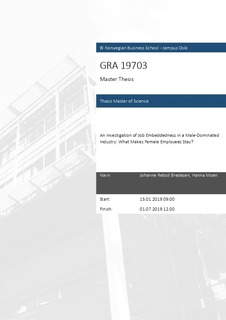| dc.description.abstract | This study aimed to investigate employee retention within the construction
industry, with a focus on how the male-dominated industry can retain its female
employees. Job embeddedness, a theory of employee retention, looks at both
organizational and community embeddedness. In line with researchers call for
studies investigating causal indicators of the construct, the current study
investigated whether the relationship between a set of employee work-related wellbeing
HR practices and turnover intention through organizational embeddedness
would be different for men and women. Furthermore, as the male-domination of
the industry might characterize the organizational climate, perceptions of
discriminatory behavior were addressed. Last, as other factors outside employees’
work can affect their decision to leave, the possible moderating effect of gender was
tested on the community embeddedness and turnover intention relationship. The
data from 132 employees working in the industry revealed non-significant results
with regards to gender as a moderator within the relationship between a set of
employee work-related well-being HR practices and turnover intention through
organizational embeddedness. However, organizational embeddedness was found
to have an indirect effect on the relationship. Through an analysis of qualitative
data, we found differences in employee perceptions of discriminatory behavior,
which indicates that HR practices and the organizational embeddedness construct
may not capture the whole story. Last, the analysis revealed a non-significant
moderation effect by gender on the relationship between community embeddedness
and turnover intention. However, men were found to have higher community
embeddedness than women. Other findings are discussed, as well as theoretical and
practical implications, limitations, and directions for future research.
Keywords: Male-dominated industry, Job Embeddedness, Work-Related Well-
Being HR practices, Perceptions of discriminatory behavior | nb_NO |
